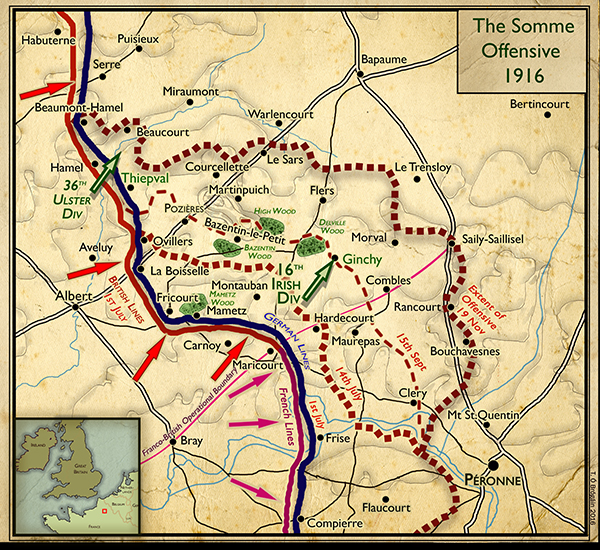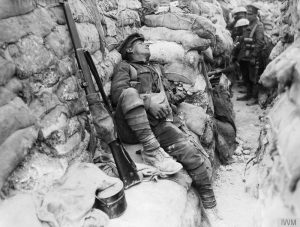CENTENARY: The Somme—the big picture
Published in Features, Issue 4 (July/August 2016), Volume 24, World War IWHY WAS THE BATTLE FOUGHT?
By Jennifer Wellington
By late 1915, the war in the west had been effectively at stalemate for months. Repeated attempts to rupture the lines of trenches, barbed wire, concrete posts and dugouts had made little real difference, despite the expenditure of hundreds of thousands of lives. The Allies and the Central Powers continued to pour men and matériel into the front, and combatant nations’ inability to produce munitions fast enough in the first months of the war led to shortages of the explosive shells needed to load heavy artillery. The introduction of frightening new weaponry such as poison gas and flame-throwers further augmented the horrors of combat. As well as the failure of offensives on the Western Front, operations in Mesopotamia and Salonika were stalled. The Gallipoli campaign, aimed at weakening the Central Powers and removing the Ottoman Empire from the war, had proved a disaster. Despite attacking the Central Powers on numerous fronts in 1915, the Allies did not coordinate their offensives. This allowed, for example, the Germans to move their troops from one front to another to shore up their defences wherever they were attacked.
At a meeting at the French commander Joffre’s headquarters in Chantilly in December 1915, the Allied high commands agreed to launch synchronised attacks on the Italian, Eastern and Western Fronts after March 1916. These attacks were intended to wear down the Central Powers by keeping them busy on multiple fronts at the same time. Owing to shortages in munitions and manpower, however, these offensives would not be ready to launch until mid-1916. They were to be, simultaneously, a Russian attack against the Germans, a French–British attack along the River Somme in Picardy and an Italian attack on their front at the same time.
Verdun
These plans, however, were pre-empted by Germany’s decision to attack the French fortress at Verdun in February 1916. Germany had entered the war with the largest munitions industry, but Erich von Falkenhayn, chief of the German general staff, realised that the balance of munitions production and manpower was moving towards the Allies. Britain, for example, produced 90 artillery pieces in 1914, but by mid-1916 they had produced 3,200 guns. These were increasingly the kind of heavy artillery needed for trench warfare. Thus Falkenhayn decided to attack France in an effort to have a major breakthrough before the balance tipped further towards the Allies. He planned to attack at a point that was sure to be defended, and then use the superiority of German artillery capacity to achieve this breakthrough by simply hammering away at it for long enough. To do this, he attacked a place that he believed the French would be sure to keep defending to the last man. This place was Verdun: a point of historical, but not strategic,significance. Verdun (and its fortress) had played an important part in French military history since the time of Charlemagne. Falkenhayn presumed that France would see losing it as a disaster and so would continue to defend to the last man.
Joffre quickly realised that the Verdun attack was a German attempt to win the war and so appealed for assistance according to the Chantilly agreement. Accordingly, Russia attacked around Lake Naroch in Belarus in March 1916. Germany stopped the advance, however, and did not draw troops away from the west to do so, as Joffre had hoped. The other Chantilly offensives also eventually went ahead, although later and not simultaneously as planned: the Russians attacked again in June in what became known as the Brusilov offensive, the British and French attacked on the Somme in July, and in August Italy commenced the sixth battle of the Isonzo.
The fighting at Verdun continued for ten months. It was characterised by intense artillery bombardment, creating fire that could be seen miles away. At the time, to the poilu or ordinary French soldier, Verdun was known as the ‘Meuse mill’, a machine that continuously minced soldiers. By November 1916 around 300,000 French and German soldiers had been killed.
Joint French/British project
This protracted slaughter meant that, although the Somme offensive had been planned prior to the German attack at Verdun, the shape of the fighting on the Somme had to be altered. The site remained the same: the Somme battlefield was selected not because there was anything of particular military significance behind the German lines at that point but because it was the junction of the French and British lines. Joffre, however, had originally conceived of the offensive as a mostly French effort, but the need to keep Verdun supplied meant that the planners reduced the projected 39 French divisions to 22 by May. As Britain was supplying nineteen divisions, the battle would now be a more equal project.


Above: An exhausted soldier asleep in a front-line trench at Thiepval, September 1916. (IWM)
German defences largely intact
When the British forces attacked on 1 July after a week-long bombardment in which their guns fired over a million shells, they found the German defences, including deep dugouts, machine-guns and artillery, largely intact. Machine-gunners in particular were able to reemerge from their deep dugouts and shoot waves of advancing troops. Combined as it was with ordering—in some areas—the volunteer infantry of Kitchener’s New Army to move forward at walking pace, for the British army the attack was a bloodbath. On 1 July, of the approximately 120,000 British troops involved, 57,000 became casualties—15,000–17,000 in the first 45 minutes. Nineteen thousand were killed. Owing to the chaos of the day and the dangers faced by stretcher-bearers crossing exposed ground in battle, huge numbers wounded in no-man’s-land died there later. Men crawled into shell holes with bibles and waterproofs, and died curled up that way.
In the French sector, the artillery bombardment was much heavier and more concentrated. The French reached their first day objectives, at the cost of 7,000 casualties. The British, except in the southern sector adjoining the French, made no gains at all. The Battle of the Somme continued in fits and starts until November 1916. For the UK, the Somme resulted in the destruction of the large volunteer armies raised between 1914 and 1916. During the Somme campaign, 432,000 of them became casualties. Approximately 150,000 of these were killed; 100,000 were wounded so severely tha they would not fight again. Germany suffered approximately 230,000 casualties, and France a further 200,000 casualties. Total casualties for the Somme numbered over 1.2 million.
Owing to the involvement of mass armies, and in the face of mounting casualty lists in the papers, people were naturally curious to learn more about what was happening at the front. By 1916, however, they would have to rely on official sources for this information. The British War Office had, from 1914 to 1916, gradually asserted more control over images of the war after a fairly laissez-faire beginning. For example, when the war broke out, perhaps one in five British officers carried a Vest Pocket Kodak camera to the front. During the first year of the war many periodicals bought photographs taken by amateur photographers at the front and published them under anonymous attributions. In June 1915, having decided that this was militarily risky, the War Office directed that each battalion was to be allowed only one camera, and the first British official photographer was appointed in March 1916. From 1916, photographs of the Western Front battlefields in the public domain almost all came from official sources. (Although numerous soldiers kept their cameras clandestinely, the illicit photographs they took would have remained private.) Exhibitions of official photographs of the battle were staged around Britain. The Battle of the Somme,the official film that the king enthused over and so many millions went to see, was shown all over the country as the battle still raged. These highly mediated films and photographs were displayed in such a way as to convince those at home that they were seeing both the unvarnished reality of combat and a conflict which was noble and worth fighting.
Jennifer Wellington lectures in modern history at University College Dublin.
FURTHER READING
R. Prior & T. Wilson, The Somme (New Haven & London, 2006).
N. Reeves, Official British film propaganda during the First World War (London, 1986).
D. Stevenson, 1914–1918: the history of the First World War (London, 2004).
H. Strachan, The First World War (London, 2004).
Read More:
The Battle of the Somme—the movie
















